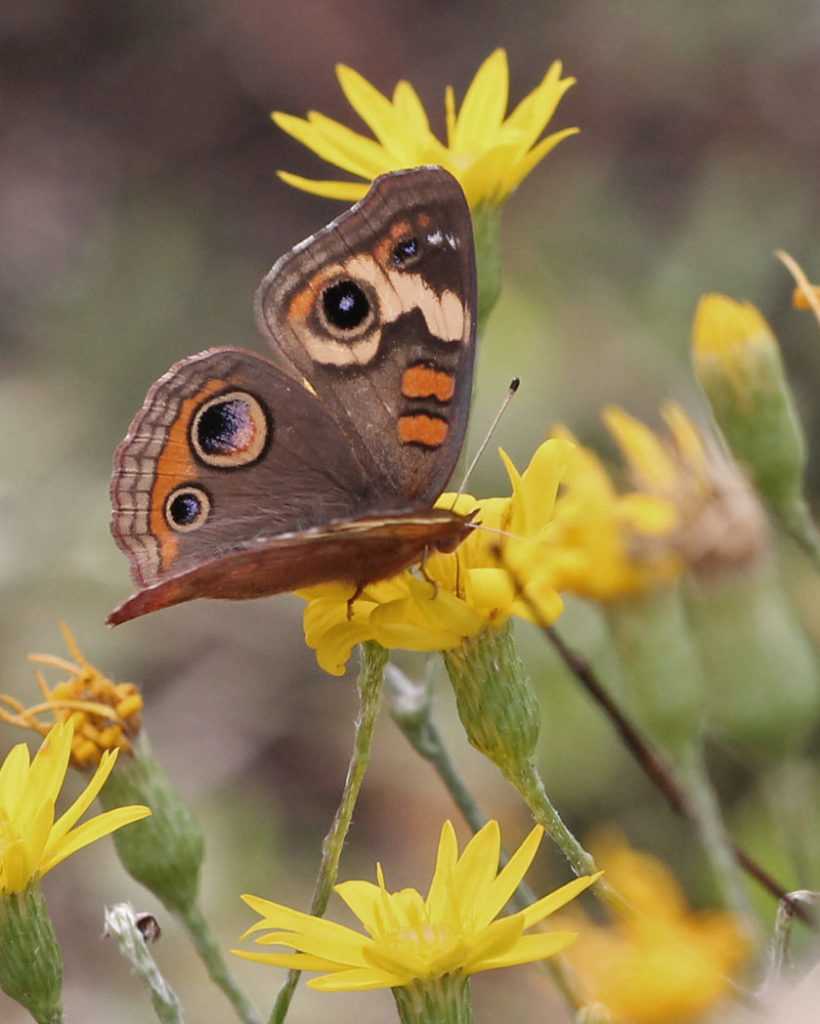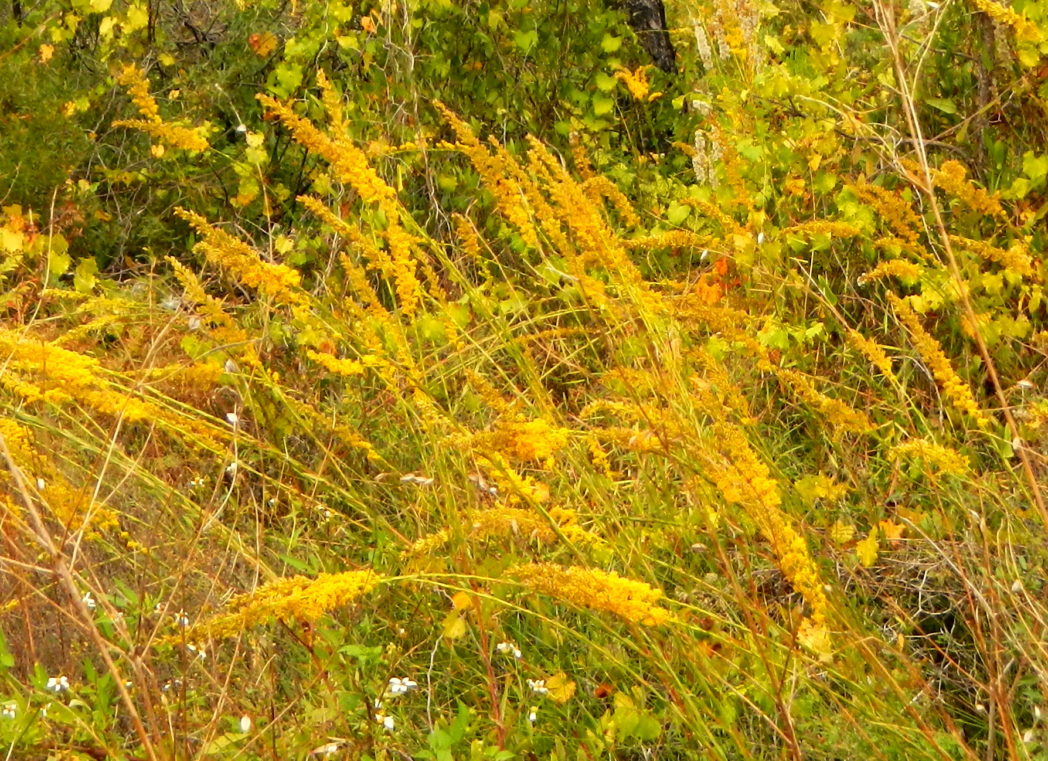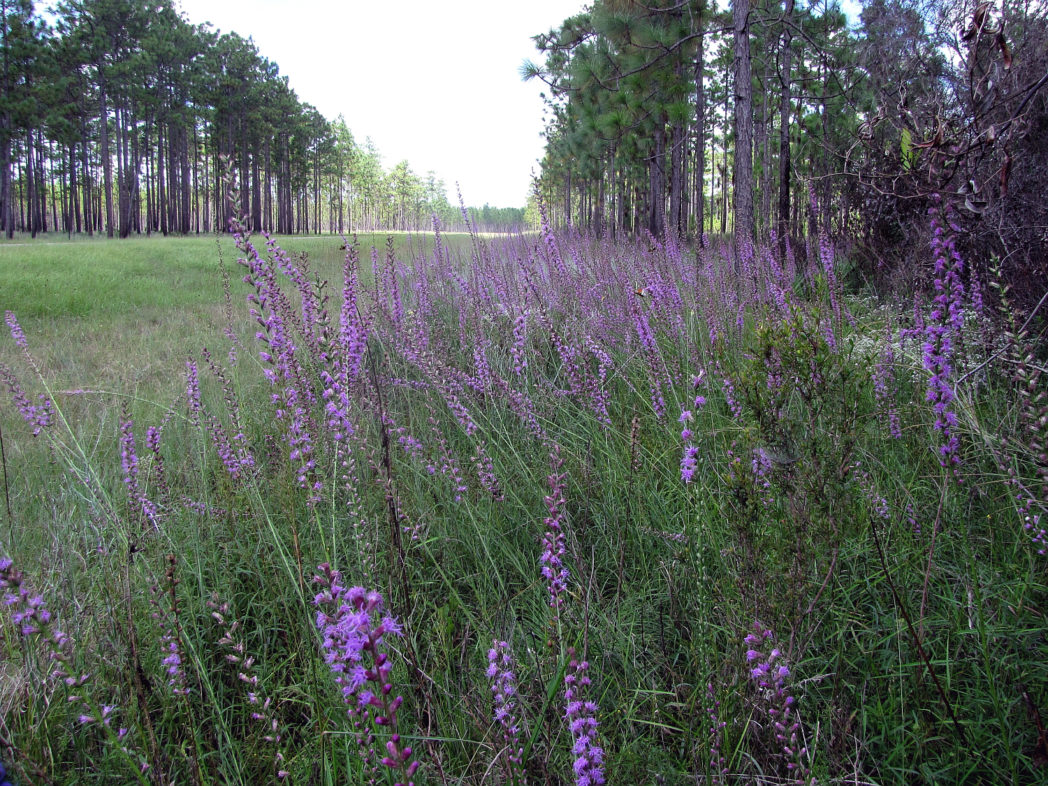Bloom Report: Yellows and lavenders dominate fall bloom
Pictured above: Dense blazing star (Liatris spicata) commonly occurs in moist areas. Photo by Jeff Norcini
Composites are wildflowers in the daisy family, formerly called Compositae, but now called Asteraceae. The original name refers to flowers comprised of showy ray flowers (petals) surrounding many tiny disc flowers, which are the fertile flowers producing the seed. Because many plants in the daisy family have yellow flowers, some botanists and plant enthusiasts refer to them as “DYCs”, d$*! yellow composites.
Many of these composites seem to make up a substantial percentage of autumn’s native wildflowers. In moist areas, roadsides and natural areas are ablaze with sunflowers (Helianthus spp.) throughout the state, and in much of the state, Florida tickseed (Coreopsis floridana) and/or Coastalplain tickseed (Coreopsis gladiata). These tickseeds are very similar in appearance, with petals of richer yellow than our native sunflowers. An easily overlooked sunflower is the appropriately named Rayless sunflower (Helianthus radula), which also occurs in moist areas and is common in all but South Florida. While this sunflower lacks the showy yellow petals of its genus, it has a unique attractiveness in large populations.
Don’t rule out dry areas
Drier areas have their share of aesthetically appealing yellow composites — Coastalplain honeycombhead (Balduina angustifolia), goldenasters (Chrysopsis spp.), Silkgrasses (Pityopsis spp.), and goldenrods (Solidago spp.). Beggarticks (Bidens alba) has bright yellow disc flowers and are pollinator magnets. Claudia Larsen of Micanopy Wildflowers notes that, “In Central Florida, it’s a Bidens alba garden party blooming everywhere on roadsides.”
Nancy Bissett, co-owner of The Natives in Davenport, expressed a similar sentiment about drier areas in Central Florida. “This year, the scrub is spectacularly fecund in both wildflowers and seed production. Fall is just starting, and with the surplus of rain this spring and summer and heading into an El Nino season, I think anyone will be rewarded with an adventure into the wild. Blazing stars, Carphephorus, Partridge pea everywhere; Solidago chapmanii and on and on. I think the main message is that this is the year to visit our more xeric landscapes.”

Complementing their yellow counterparts in natural areas and along roadsides throughout the state are one or more species of the showy, petal-less purple composites: Chaffheads (Carphephorus spp.), blazing stars, (Liatris spp.), Ironweeds (Vernonia spp.), and dainty-flowered Elephantsfoots (Elephantopus elata).
While the composites put on great displays of fall color, there are other eye-catching native wildflowers and grasses blooming throughout the state. In addition to Partidge pea (Chamaecrista fasciculata), look for pinkish-purple false foxgloves (Agalinis spp.) and the impressive pinkish-purple inflorescences of Hairawn muhly grass (Muhlenbergia capillaris var. capillaris, and var. filipes) and Purple lovegrass (Eragrostis spectabilis).
Another native grass, and one which is hard to miss because it often occurs in colonies, is Chalky bluestem (Andropogon virginicus var. glaucus). The masses of bluish-gray stems make for a “striking display,” says Bob Farley, FDOT District 3 vegetation project manager.
If you are an orchid enthusiast, head to South Florida. Author and botanist Roger Hammer notes that, “October through November is when I always go out to the Taylor Slough bridge in Everglades National Park to see Spiranthes odorata in bloom in the flooded prairies right along the roadside.” Other fall-blooming orchids in South Florida are Wild coco (Eulophia alta), a few Star orchid species (Epidendrum spp.), and two Reinorchids (Habenaria spp.).
Where to look for wildflowers
While the outlook is promising for fall wildflowers in general, look for exceptional displays in moist and wet areas because of the frequent summer rains and above-normal chances for a wet fall in North and Central Florida.
Hotspots include:
- Roadsides: Rural ditches and swales where reduced mowing has been implemented, especially in counties that have officially adopted a Wildflower Resolution to encourage and implement practices that conserve and promote roadside wildflowers. For more information and a map of counties that enacted a wildflower resolution, visit Protect Roadside Wildflowers.
- Natural Areas: Pine flatwoods, especially those that are regularly burned.
Panhandle
- SR 65 (Liberty County)
- SR 267 (Leon and Wakulla counties, mainly in the Apalachicola National Forest)
- West of Apalachicola River (any roadside that borders a scrub community)

Click for more information on visiting the Panhandle’s wildflower hotspots.
North Florida
- Gold Head State Park (Keystone Heights)
- Paynes Prairie Preserve State Park (Gainesville)
Central Florida
- Bok Tower Gardens (Lake Wales)
- Little Manatee River State Park (Wimauma)
- Wekiwa Springs State Park (Apopka)
- Ocala National Forest
South Florida
Below Lake Okeechobee, roadside vegetation management practices along with widespread exotic grasses severely impede the occurrence of native roadside wildflowers. The best places to see them in this part of the state are national, state, local and private preserves, including:
- Big Cypress National Preserve (main entrance – Ochopee)
- Everglades National Park (main entrance – Homestead)
- CREW Marsh trails (Immokalee)
Dr. Jeff Norcini has a consulting business, OecoHort, LLC, and is FDOT’s wildflower specialist, Tallahassee. Thank you to Nancy Bissett, Bob Farley, Roger Hammer and Claudia Larsen for their viewing suggestions.

